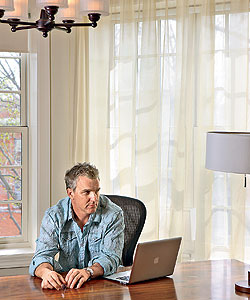 |
When Mark Richard Smith woke up alone in a St. Louis hotel room in September 2007, he thought his chest pains were due to stress. “It wasn’t until I was in the emergency room that I knew I’d had a heart attack,” says Smith, an athletic 48-year-old who nearly overexerted himself making the first documentary about the life and work of the architect Louis Sullivan. With no prior experience, Smith was scouting locations, applying for grants, and conducting extensive research. Then he landed in the hospital. Suddenly, Smith was sacrificing his own life for his mission—similar to the very subject of his film.
The experience only ratcheted up his level of commitment. “That’s when I thought, I’m not going to fool around,” he says. After all, Smith, a Sheridan Park resident who previously owned a Texas-based graphic design company, had waited until he was in his 40s to pursue his real passion—history—at Loyola University. There, for his thesis, he researched early 20th-century housing discrimination on the South Side and found photographs of demolished Sullivan buildings. One in particular—a once-opulent house on South Ellis Avenue—inspired him to combine his love for history and film and embark upon a film on the architect. “Sullivan died destitute because he wouldn’t compromise on his artistic principles, and then [Richard] Nickel [the preservationist inside Sullivan’s Chicago Stock Exchange when it collapsed in 1972] died because he would not let go of Sullivan’s legacy,” says Smith. “I thought, I have to do this film or someone else is going to.”
Since his hospital stay, Smith has sunk a quarter million dollars—his life savings—into the project. He has interviewed Sullivan scholars and architectural historians and hired a technocrane operator to capture the gilded arches of the Auditorium Theatre. Now, nearly two years after his near-death experience, Smith faces a filmmaker’s biggest hurdle: distribution. He has already screened highlights for the American Institute of Architects, the Society of Architectural Historians, and the Frank Lloyd Wright Preservation Trust. The architecture world is buzzing. Other filmmakers are talking about his work, too. “This is a film that is long overdue,” says Margie Newman, an independent filmmaker who coproduced a documentary about Nickel for WTTW/Channel 11.
But when the film will start traveling the festival circuit and be available for wider screenings has not been established. Smith, meanwhile, stays convinced that he can ride a swell of interest in architecture films. “I don’t want to sound grandiose,” he admits, “but I identify with Sullivan a little bit. He really went his own way. I want to get this film done, and I want to do it my way. When people see what’s up there [on the screen], they will respond to it.” For more information, or to see a trailer for the film, go to louissullivanfilm.com.
Photograph: Katrina Wittkamp



